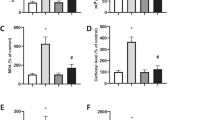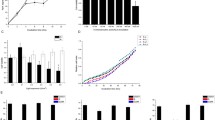Abstract
Singlet oxygen is a highly reactive form of molecular oxygen that may harm living systems by oxidizing critical cellular macromolecules and it also promotes deleterious processes such as cell death. Recently, we demonstrated that the control of redox balance and the cellular defense against oxidative damage are the primary functions of cytosolic NADP+-dependent isocitrate dehydrogenase (IDPc) through supplying NADPH for antioxidant systems. In this report, we demonstrate that modulation of IDPc activity in HL-60 cells regulates singlet oxygen-induced apoptosis. When we examined the protective role of IDPc against singlet oxygen-induced apoptosis with HL-60 cells transfected with the cDNA for mouse IDPc in sense and antisense orientations, a clear inverse relationship was observed between the amount of IDPc expressed in target cells and their susceptibility to apoptosis. The results suggest that IDPc plays an important protective role in apoptosis of HL-60 cells induced by singlet oxygen.






Similar content being viewed by others
References
Kanofsky JR (1989) Singlet oxygen production by biological systems. Chemico-Biol Interact 70:1–28
Niziolek M, Korytowski W, Girotti AW (2005) Self-sensitized photodegradation of membrane-bound protoporphyrin mediated by chain lipid peroxidation: inhibition by nitric oxide with sustained singlet oxygen damage. Photochem Photobiol 81:299–305
Halliwell B, Gutteridge JMC (1999) Free radicals in biology and medicine. Oxford Press, Oxford
McCord JM, Fridovich I (1969) Superoxide dismutase. An enzymic function for erythrocuprein (hemocuprein). J Biol Chem 244:6049–6055
Chance B, Sies H, Boveris A (1979) Hydroperoxide metabolism in mammalian organs. Physiol Rev 59:527–605
Koshland DE Jr, Walsh K, LaPorte DC (1985) Sensitivity of metabolic fluxes to covalent control. Curr Top Cell Regul 27:13–22
Kirsch M, De Groot H (2001) NAD(P)H, a directly operating antioxidant? FASEB J 15:1569–1574
Nakamura H (2005) Thioredoxin and its related molecules: update 2005. Antioxid Redox Signal 7:823–828
Lee SM, Koh HJ, Park DC, Song BJ, Huh TL, Park JW (2002) Cytosolic NADP+-dependent isocitrate dehydrogenase status modulates oxidative damage to cells. Free Radic Biol Med 32:1185–1196
Zerez CR, Lee SJ, Tanaka KR (1987) Spectrophotometric determination of oxidized and reduced pyridine nucleotides in erythrocytes using a single extraction procedure. Anal Biochem 164:367–373
Tauskela JS, Hewitt K, Kang LP, Comas T, Gendron T, Hakim A, Hogan M, Durkin J, Morley P (2001) Evaluation of glutathione-sensitive fluorescent dyes in conical culture. Glia 30:329–341
Pastorino JG, Simbula G, Yamamoto K, Glascott PA, Rothman RJ, Farber JL (1996) The cytotoxicity of tumor necrosis factor depends on induction of the mitochondrial permeability transition. J Biol Chem 271:29792–29798
Sundaresan M, Yu ZX, Ferrans CJ, Irani K, Finkel T (1995) Requirement for generation of H2O2 for platelet-derived growth factor signal transduction. Science 270:296–299
Kroemer G, Zamzami N, Susin SA (1997) Mitochondrial control of apoptosis. Immunol Today 18:44–51
Krinsky NI (1974) Membrane photochemistry and photobiology. Photochem Photobiol 20:532–535
Foote CS (1976) Photosensitized oxidation and singlet oxygen: consequences in biological systems. In: Pyror WA (ed) Free radicals in biology, vol 2. Academic Press, New York, pp 85–133
Joshi PC (1985) Comparison of the DNA-damaging property of photosensitised riboflavin via singlet oxygen (1O2) and superoxide radical O −. 2 Mechanisms. Toxicol Lett 26:211–217
de Mol NJ, van Henegouven GMJB, van Beele B (1981) Singlet oxygen formation by sensitization of furocoumarins complexed with, or bound covalently to DNA. Photochem Photobiol 34:661–666
Weishaupt KR, Gomer CJ, Dougherty YJ (1976) Identification of singlet oxygen as the cytotoxic agent in photoinactivation of a murine tumor. Cancer Res 36:2326–2329
Hasan T, Khan AU (1986) Phototoxicity of the tetracyclines: photosensitized emission of singlet delta dioxygen. Proc Natl Acad Sci USA 83:4604–4606
Mathews-Roth MM (1986) Beta-carotene therapy for erythropoietic protoporphyria and other photosensitivity diseases. Biochimie 68:875–884
Egorov SI, Babizhaev MA, Krasnovskii AA, Shredova AA (1987) Photosensitized generation of singlet molecular oxygen by endogenous substances of the eye lens. Biofizika 32:169–171
Henderson BW, Dougherty TJ (1992) How does photodynamic therapy work? Photochem Photobiol 55:145–157
Holmgren A (2000) Antioxidant function of thioredoxin and glutaredoxin systems. Antioxid Redox Signal 2:811–820
Rhee SG, Chae HZ, Kim K (2005) Peroxiredoxins: a historical overview and speculative preview of novel mechanisms and emerging concepts in cell signaling. Free Radic Biol Med 38:1543–1552
Schallreuter KU, Rubsam K, Chavan B, Gillbro JM, Spencer JD, Wood JM (2006) Functioning methionine sulfoxide reductase A and B are present in human epidermal melanocytes in the cytosol and in the nucleus. Biochem Biophys Res Commun 342:145–152
Kletzien RF, Harris PKW, Foellmi LA (1994) Glucose-6-phosphate dehydrogenase: a “housekeeping” enzyme subject to tissue-specific regulation by hormones, nutrients, and oxidant stress. FASEB J 8:174–181
Pandolfi PP, Sonati F, Rivi R, Mason P, Grosveld F, Luzzatto L (1995) Targeted disruption of the housekeeping gene encoding glucose 6-phosphate dehydrogenase (G6PD): G6PD is dispensable for pentose synthesis but essential for defense against oxidative stress. EMBO J 14:5209–5215
Veech RL, Eggleston LV, Krebs HA (1969) The redox state of free nicotinamide-adenine dinucleotide phosphate in the cytoplasm of rat liver. Biochem J 115:609–619
Meister A, Anderson ME (1983) Glutathione. Ann Rev Biochem 52:711–760
de Grey AD (2000) The reductive hotspot hypothesis: an update. Arch Biochem Biophys 373:295–301
Atamna H, Paler-Martinez A, Ames BN (2000) N-t-Butyl hydroxylamine, a hydrolysis product of α-phenyl-N-t-butyl nitrone, is more potent in delaying senescence in human lung fibroblasts. J Biol Chem 275:6741–6748
Yang E, Korsmeyer SJ (1996) Molecular thanatopsis: a discourse on the Bcl-2 family and cell death. Blood 88:386–401
Acknowledgment
This work was supported by a grant from the Korea Research Foundation (KRF-2005-070-C00100).
Author information
Authors and Affiliations
Corresponding author
Rights and permissions
About this article
Cite this article
Kim, S.Y., Lee, S.M., Tak, J.K. et al. Regulation of singlet oxygen-induced apoptosis by cytosolic NADP+-dependent isocitrate dehydrogenase. Mol Cell Biochem 302, 27–34 (2007). https://doi.org/10.1007/s11010-007-9421-x
Received:
Accepted:
Published:
Issue Date:
DOI: https://doi.org/10.1007/s11010-007-9421-x




